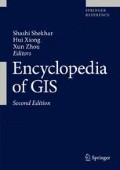Access this chapter
Tax calculation will be finalised at checkout
Purchases are for personal use only
References
Adilmagambetov A, Zaïane OR, Osornio-Vargas A (2013) Discovering co-location patterns in datasets with extended spatial objects. In: Proceedings of the 15th int’l conference on data warehousing and knowledge discovery, Prague, Czech Republic, pp 84–96
Agrawal R, Srikant R (1994) Fast algorithms for mining association rules in large databases. In: Proceedings of the 20th int’l conference on very large data bases, Santiago de Chile, Chile, pp 487–499
Baddeley AJ (2007) Spatial point processes and their applications. In: Lecture notes in mathematics: stochastic geometry. Springer, Berlin/Heidelberg
Barua S, Sander J (2011) SSCP: mining statistically significant co-location patterns. In: Proceedings of the 12th int’l symposium on advances in spatial and temporal databases, Minneapolis, MN, USA, pp 2–20
Barua S, Sander J (2014a) Mining statistically significant co-location and segregation patterns. IEEE Trans Knowl Data Eng 26(5):1185–1199
Barua S, Sander J (2014b) Mining statistically sound co-location patterns at multiple distances. In: Proceedings of the 26th int’l conference on scientific and statistical database management, Aalborg, Denmark, p 7
Celik M, Shekhar S, Rogers JP, Shine JA (2008) Mixed-drove spatiotemporal co-occurence pattern mining. IEEE Trans Knowl Data Eng 20(10):1322–1335
Cressie NAC (1993) Statistics for spatial data. Wiley, New York
Diggle PJ (1986) Displaced amacrine cells in the retina of a Rabbit: analysis of a bivariate spatial point pattern. J Neurosci Methods 18(1–2):115–25
Gusmao LC, Daly M (2010) Evolution of sea anemones (Cnidaria: Actiniaria: Hormathiidae) symbiotic With Hermit Crabs. Mol Phylogenet Evol 56(3):868–877
Huang Y, Shekhar S, Xiong H (2004) Discovering co-location patterns from spatial data sets: a general approach. IEEE Trans Knowl Data Eng 16(12):1472–1485
Illian J, Penttinen A, Stoyan H, Stoyan D (2008) Statistical analysis and modelling of spatial point patterns. Wiley, Chichester, West Sussex
Koperski K, Han J (1995) Discovery of spatial association rules in geographic information databases. In: Proceedings of the 4th int’l symposium on advances in spatial databases, Portland, Maine, USA, pp 47–66
Mane S, Murray C, Shekhar S, Srivastava J, Pusey A (2005) Spatial clustering of chimpanzee locations for neighborhood identification. In: Proceedings of the 5th IEEE int’l conference on data mining, Houston, Texas, USA, pp 737–740
Ripley BD (1976) The second-order analysis of stationary point processes. J Appl Probab 13(2):255–266
Roxburgh SH, Matsuki M (1999) The statistical validation of null models used in spatial association analyses. Nord Soc Oikos 85(1):68–78
Shekhar S, Huang Y (2001) Discovering spatial co-location patterns: a summary of results. In: Proceedings of the 7th int’l symposium on spatial and temporal databases, Redondo Beach, CA, USA, pp 236–256
Xiao X, Xie X, Luo Q, Ma W-Y (2008) Density based co-location pattern discovery. In: Proceedings of the 16th ACM int’l symposium on advances in geographic information systems, Irvine, California, USA, pp 250–259
Yoo JS, Shekhar S (2004) A partial join approach for mining co-location patterns. In: Proceedings of the 12th ACM int’l workshop on geographic information systems, Washington, DC, USA, pp 241–249
Yoo JS, Shekhar S (2006) A joinless approach for mining spatial colocation patterns. IEEE Trans Knowl Data Eng 18(10):1323–1337
Yoo JS, Shekhar S, Kim S, Celik M (2006) Discovery of co-evolving Spatial Co-located Event Sets. In: Proceedings of the 6th SIAM int’l conference on data mining, Bethesda, MD, USA, pp 306–315
Author information
Authors and Affiliations
Corresponding author
Editor information
Editors and Affiliations
Rights and permissions
Copyright information
© 2017 Springer International Publishing AG
About this entry
Cite this entry
Barua, S., Sander, J. (2017). Statistically Significant Co-location Pattern Mining. In: Shekhar, S., Xiong, H., Zhou, X. (eds) Encyclopedia of GIS. Springer, Cham. https://doi.org/10.1007/978-3-319-17885-1_1552
Download citation
DOI: https://doi.org/10.1007/978-3-319-17885-1_1552
Published:
Publisher Name: Springer, Cham
Print ISBN: 978-3-319-17884-4
Online ISBN: 978-3-319-17885-1
eBook Packages: Computer ScienceReference Module Computer Science and Engineering

